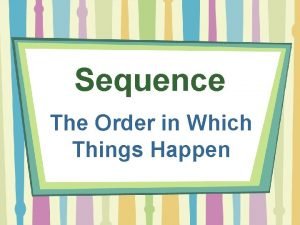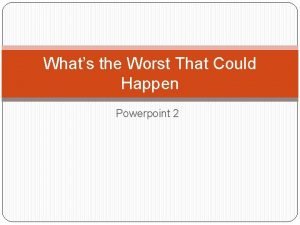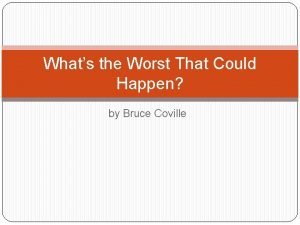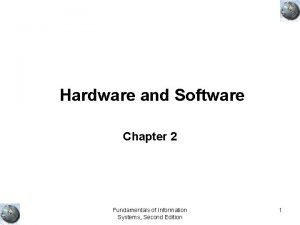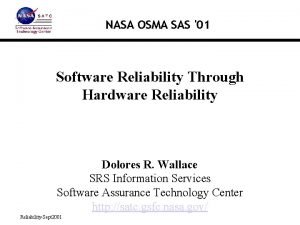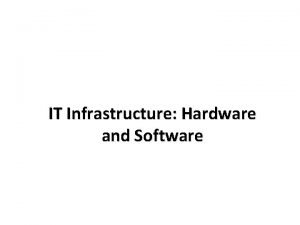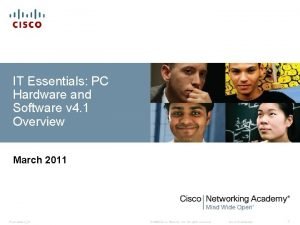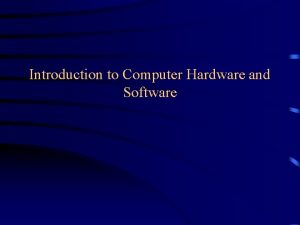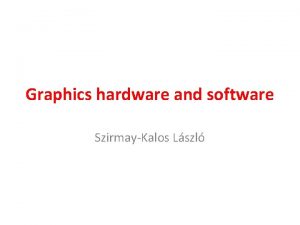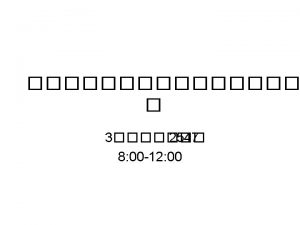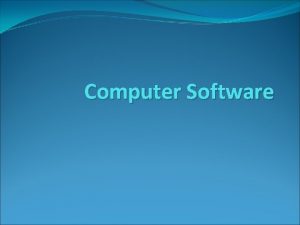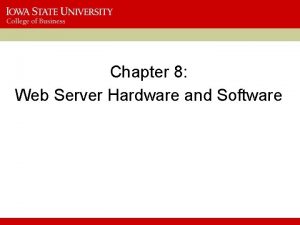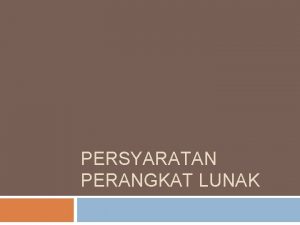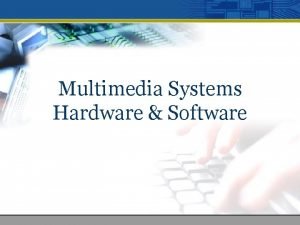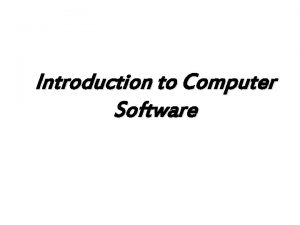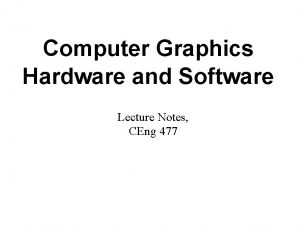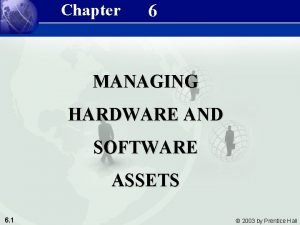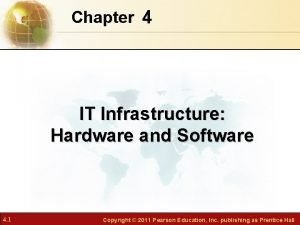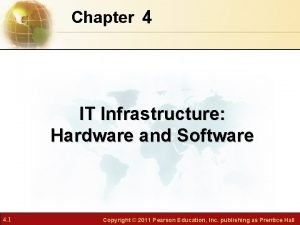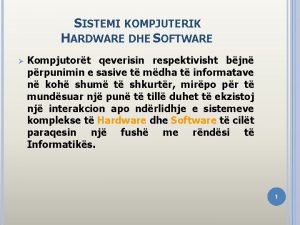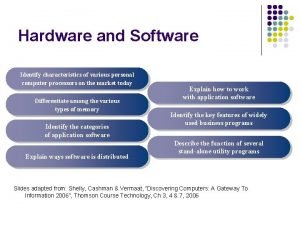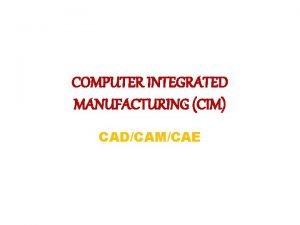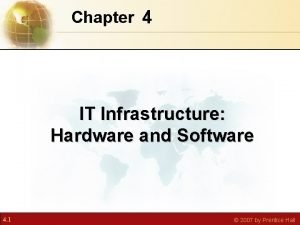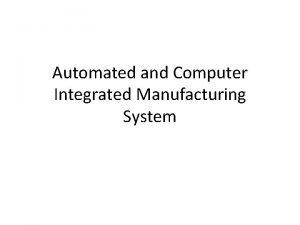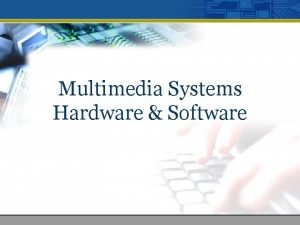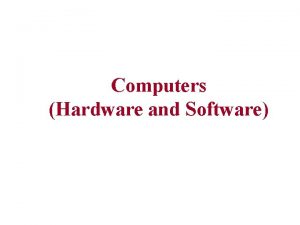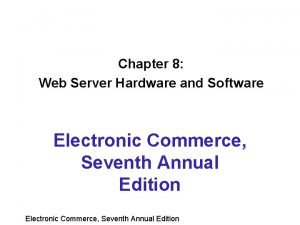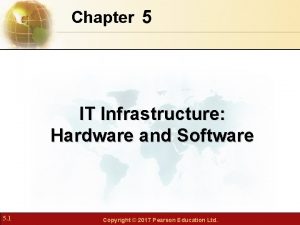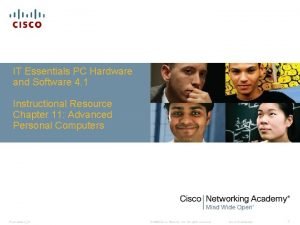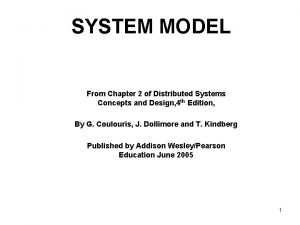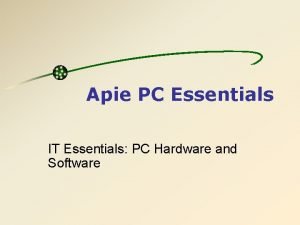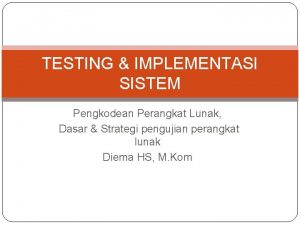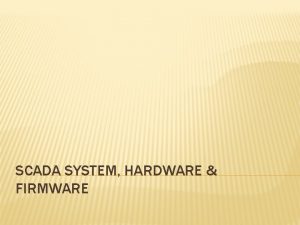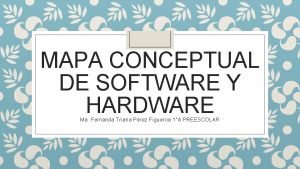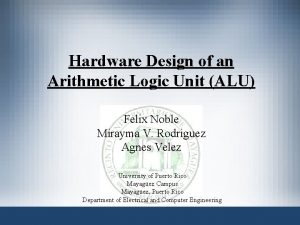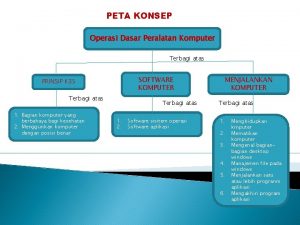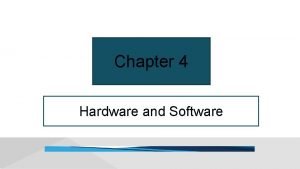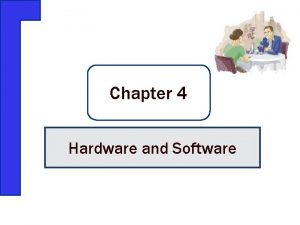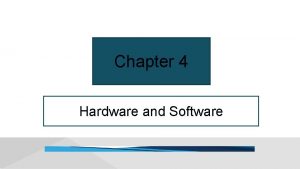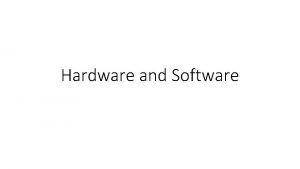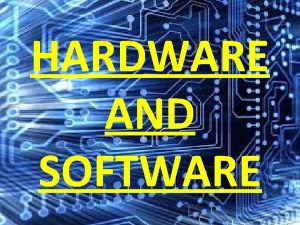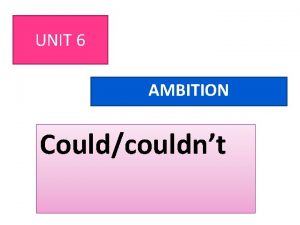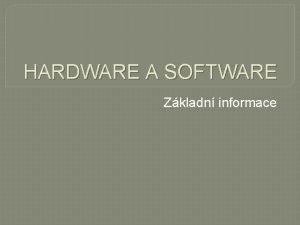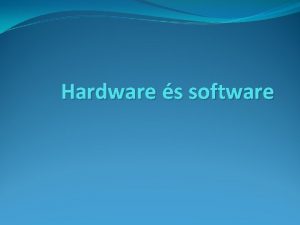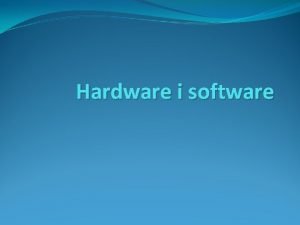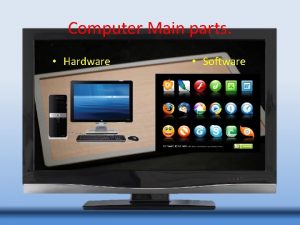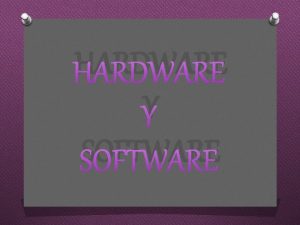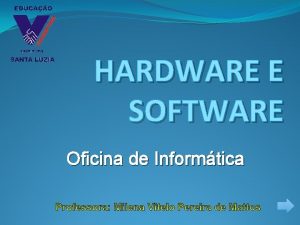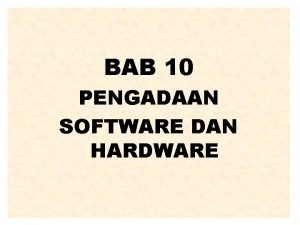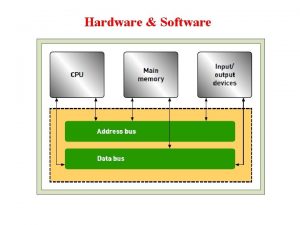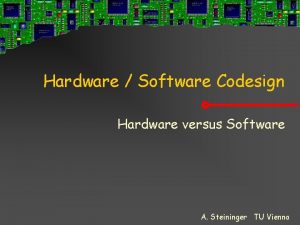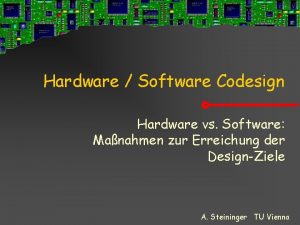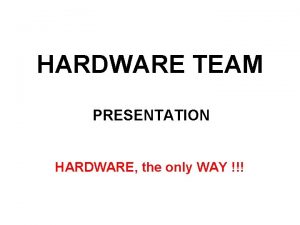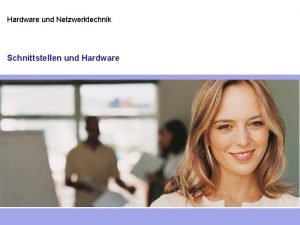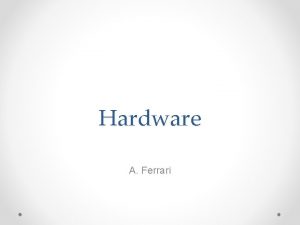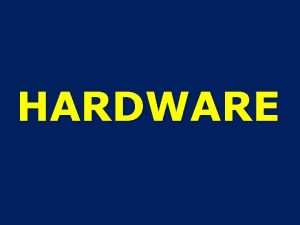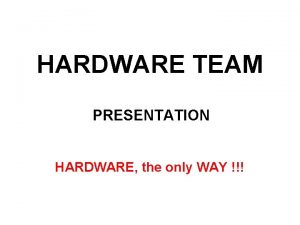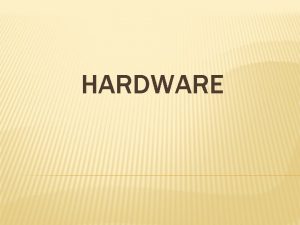Chapter 4 Hardware and Software This Could Happen







































- Slides: 39

Chapter 4 Hardware and Software

This Could Happen to You: “We Called It Strangle and Cram” “Strangle and cram” • Cut off support to an older version of a product (strangle) and tell your customers that to get support they have to upgrade to the new version (cram) Neil suggest going to a thin client/server architecture using open source software Flex. Time scenario video Copyright © 2012 Pearson Education, Inc. Publishing as Prentice Hall 4 -2

Study Questions Copyright © 2012 Pearson Education, Inc. Publishing as Prentice Hall 4 -3

Q 1: What Do Business Professionals Need to Know About Computer Hardware? Watch the video clip Copyright © 2012 Pearson Education, Inc. Publishing as Prentice Hall 4 -4

Other Components Scantron Scanner Special Function Card Copyright © 2012 Pearson Education, Inc. Publishing as Prentice Hall 4 -5

Computer Data • Binary digits (bits) ―Used to represent data ―Bit is either 0 or 1 Copyright © 2012 Pearson Education, Inc. Publishing as Prentice Hall 4 -6

Computer Data (cont’d) • Sizing Computer Data ―Bytes ― 8 -bit chunk = 1 byte • Important storage capacity terminology Copyright © 2012 Pearson Education, Inc. Publishing as Prentice Hall 4 -7

How Does a Computer Work? Copyright © 2012 Pearson Education, Inc. Publishing as Prentice Hall 4 -8

How Does a Computer Work? (cont’d) (click here for more info) CPU (Central Processing Unit) Transfers program or data from disk to main memory Moves instruction from main memory via data channel or bus Has small amount of fast memory called cache Copyright © 2012 Pearson Education, Inc. Publishing as Prentice Hall 4 -9

How Does a Computer Work? (cont’d) Main memory contains Operating system (OS) • Program instructions • Operating system instructions • Program that controls computer’s resources and blocks of data • Provides services to application programs and users Copyright © 2012 Pearson Education, Inc. Publishing as Prentice Hall 4 -10

Memory Swapping Occurs when RAM is too small to hold all open programs and data CPU loads new program segments into unused memory • If none available, operating system swaps out existing instructions, or data, to a disk and copy requested program, or data, to freed space • Swapping slows down your computer Copyright © 2012 Pearson Education, Inc. Publishing as Prentice Hall 4 -11

Why Should a Manager Care How a Computer Works? Main memory size CPU speed • Too little means constant memory swapping • Need more memory for processing many programs or large files • Expressed in hertz (Hz): Ø Electrical voltage that changes from low to high and back again at regular intervals. • Need more speed if handling large spreadsheets or database files • 32 -bit CPU 4 GB RAM • 64 -bit CPU almost unlimited RAM Copyright © 2012 Pearson Education, Inc. Publishing as Prentice Hall 4 -12

Why Should a Manager Care How a Computer Works? (cont’d) Cache and main memory are “volatile” • Contents lost when power is cut off Stores frequently used instructions Large cache makes computer fast, but more expensive Magnetic and optical disks are “nonvolatile” ―Saved contents survive after power is off ―Used for secondary storage Copyright © 2012 Pearson Education, Inc. Publishing as Prentice Hall 4 -13

Q 2: What’s the Difference Between a Client and a Server? • • Client computers used for word processing, spreadsheets, database access Servers provide services to clients Copyright © 2012 Pearson Education, Inc. Publishing as Prentice Hall 4 -14

Server farm • • Large collection of coordinated servers Amazon can process 110 order items per second Google Data sites Inside a Google Data Center (video) Copyright © 2012 Pearson Education, Inc. Publishing as Prentice Hall 4 -15

Q 3: What Do Business Professionals Need to Know About Software? Operating systems Run only on particular types of hardware Must conform to instruction set of CPU Windows works only on Intel instruction set CPUs Application programs Written for a particular operating system Copyright © 2012 Pearson Education, Inc. Publishing as Prentice Hall 4 -16

What a Manager Needs to Know about Software (Watch video) Four major operating systems • • Windows (95% of business users) Mac OS (graphic arts) Unix (scientific & engineering applications) Linux (open source community) Copyright © 2012 Pearson Education, Inc. Publishing as Prentice Hall 4 -17

What a Manager Needs to Know about Software (cont’d) Copyright © 2012 Pearson Education, Inc. Publishing as Prentice Hall 4 -18

Own vs. License Right to use specified number of copies of a program Site License Flat fee payment for right to install software product on all company computers or computers at specific site Limits vendor’s liability Copyright © 2012 Pearson Education, Inc. Publishing as Prentice Hall 4 -19

Cloud Computing and Virtualization CLOUD computing IBM Google docs and spreadsheets Facebook Virtualization Guest Operating Systems Window s Linux Oracle Server virtualization makes cloud computing feasible Copyright © 2012 Pearson Education, Inc. Publishing as Prentice Hall 4 -20

What Types Of Applications Exist and How Do Organizations Obtain Them? Copyright © 2012 Pearson Education, Inc. Publishing as Prentice Hall 4 -21

What Is Firmware? Computer software installed into hardware devices • Printers, print servers, communication devices • Coded like other software • Installed into read-only memory • Can be changed and upgraded Copyright © 2012 Pearson Education, Inc. Publishing as Prentice Hall 4 -22

Experiencing MIS In. Class Exercise 4: Purchasing a Computer Form a team to identify most appropriate computer for three different scenarios. For each scenario, determine hardware and software requirements: size and type of computer, processor speed, size of main memory and disk, operating system, application programs, maintenance and support agreements, and any other factors you deem appropriate. • Scenario 1: Political science major asks you to help her purchase a new laptop computer. Wants to use computer for email, Internet access, and for note-taking in class, and spend less than $1, 000. • Scenario 2: Father: email, Internet access, downloading pictures from digital camera, uploading pictures to a shared photo service, and creating documents for members of his antique auto club. • Scenario 3: You and a group of five students have decided to replace campus newspaper with your own newspaper. Should you buy three offered by university? Copyright © 2012 Pearson Education, Inc. Publishing as Prentice Hall 4 -23

Q 4: Why Are Thin Clients Preferred to Thick Clients? Thin client • Requires nothing more than browser • Does not require installation and administration of client software Thick client • Has more code to run on it • More features and functions • More expense and administration Copyright © 2012 Pearson Education, Inc. Publishing as Prentice Hall 4 -24

Thin and Thick Clients Copyright © 2012 Pearson Education, Inc. Publishing as Prentice Hall 4 -25

Q 5 Is Open Source Software a Viable Alternative? GNU general public license (GPL) agreement • Standard for open source software Successful open source projects • Open. Office (a Microsoft Office look-alike) • Firefox (a browser) • My. SQL (a DBMS, see Chapter 5) • Apache (a web server, see Chapter 8) • Ubuntu (a Windows-like desktop operating system) • Android (a mobile-device operating system) Copyright © 2012 Pearson Education, Inc. Publishing as Prentice Hall 4 -26

Why Do Programmers Volunteer Their Services Open Source Projects? Programming intense combination of art and logic Freedom to choose projects work on Exercise creativity working on interesting and fulfilling projects Exhibit one’s skill in order to get a job Start a business selling services to support an open source product Copyright © 2012 Pearson Education, Inc. Publishing as Prentice Hall 4 -27

How Does Open Source Work? Machine code: Source code is compiled into instructions executed directly by a computer’s CPU Source code: Human readable computer code Software Closed-source or proprietary software. Source code is not available to users or public. Only available to trusted employees and carefully vetted contractors. Open-source software available to users in source code form. Copyright © 2012 Pearson Education, Inc. Publishing as Prentice Hall 4 -28

Source Code Sample Copyright © 2012 Pearson Education, Inc. Publishing as Prentice Hall 4 -29

So, Is Open Source Viable? Copyright © 2012 Pearson Education, Inc. Publishing as Prentice Hall 4 -30

How Does the Knowledge in This Chapter Help Kelly and You? Flex. Time wants to examine all of its valuegenerating activities and determine if there isn’t some way to reduce costs without reducing value generated. Knowing process for tracing development from analysis of industry structure through to requirements for information systems is important to ensure all activities in firm facilitate organization’s competitive strategy. Copyright © 2012 Pearson Education, Inc. Publishing as Prentice Hall 4 -31

Ethics Guide: Churn and Burn Mark suggests a conspiracy between hardware and software vendors • Hardware vendors create new, faster computers • Software vendors create products with more features Ø Time-consuming to learn Ø Features only needed by some users Copyright © 2012 Pearson Education, Inc. Publishing as Prentice Hall 4 -32

Ethics Guide: Churn and Burn (cont’d) Products have defects • Viruses an example • Vendors turn these into a sales advantage Should users accept these problems? Should they rise up in protest? What should vendors do? Copyright © 2012 Pearson Education, Inc. Publishing as Prentice Hall 4 -33

Guide: Keeping up to Speed Copyright © 2012 Pearson Education, Inc. Publishing as Prentice Hall 4 -34

Guide: Keeping up to Speed (cont’d) Copyright © 2012 Pearson Education, Inc. Publishing as Prentice Hall 4 -35

Active Review Copyright © 2012 Pearson Education, Inc. Publishing as Prentice Hall 4 -36

Case Study 4: Dell Leverages the Internet, Directly, but for How Long? Video Copyright © 2012 Pearson Education, Inc. Publishing as Prentice Hall 4 -37

Dell Case Study (cont’d) Copyright © 2012 Pearson Education, Inc. Publishing as Prentice Hall 4 -38

All rights reserved. No part of this publication may be reproduced, stored in a retrieval system, or transmitted, in any form or by any means, electronic, mechanical, photocopying, recording, or otherwise, without the prior written permission of the publisher. Printed in the United States of America. Copyright © 2012 Pearson Education, Inc. Publishing as Prentice Hall
 The order in which things happen is called
The order in which things happen is called What's the worst that could happen comprehension questions
What's the worst that could happen comprehension questions What's the worst that could happen by bruce coville
What's the worst that could happen by bruce coville Internal and external parts of computer
Internal and external parts of computer Chapter 2 hardware and software
Chapter 2 hardware and software Difference between hardware and software
Difference between hardware and software Hardware and software infrastructure
Hardware and software infrastructure It essentials virtual desktop
It essentials virtual desktop Software and hardware definition
Software and hardware definition Vbo1
Vbo1 Hardware software and peopleware
Hardware software and peopleware Interface between hardware and software
Interface between hardware and software Web server hardware and software
Web server hardware and software Hardware reliability in software engineering
Hardware reliability in software engineering Persyaratan spesifikasi perangkat
Persyaratan spesifikasi perangkat Multimedia hardware and software
Multimedia hardware and software Hardware introduction
Hardware introduction Hardware and software of computer graphics
Hardware and software of computer graphics Managing hardware and software assets
Managing hardware and software assets Hardware and software infrastructure
Hardware and software infrastructure It infrastructure hardware and software
It infrastructure hardware and software Hardware dhe software
Hardware dhe software Characteristics of hardware and software
Characteristics of hardware and software Objectives of cim
Objectives of cim It infrastructure hardware and software
It infrastructure hardware and software Cim hardware and software
Cim hardware and software Multimedia hardware and software
Multimedia hardware and software A computer system consists of both hardware and software
A computer system consists of both hardware and software Web server hardware and software
Web server hardware and software It infrastructure hardware and software
It infrastructure hardware and software It essentials pc hardware and software
It essentials pc hardware and software E commerce hardware
E commerce hardware Interaction model in distributed system
Interaction model in distributed system It essentials pc hardware and software
It essentials pc hardware and software Auto coding software
Auto coding software Scada is a software or hardware
Scada is a software or hardware Mapa mental de software y hardware
Mapa mental de software y hardware Hardware dan software jaringan komputer
Hardware dan software jaringan komputer Alu hardware
Alu hardware Buatlah peta konsep tentang hardware
Buatlah peta konsep tentang hardware
